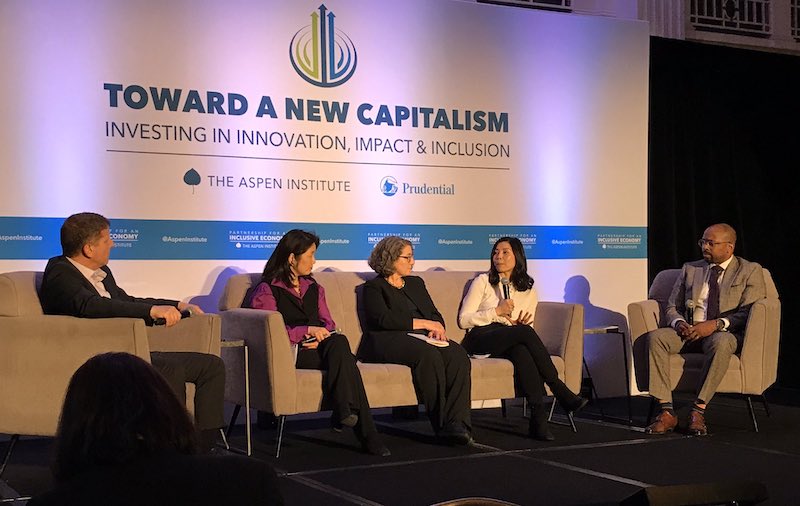ImpactAlpha, March 10 – Suddenly, it seems, capitalism is being reimagined, reinvented or reset. For impact investing practitioners, however, the ‘new capitalism’ is an overnight sensation 40 years in the making.
One of ImpactAlpha’s founding precepts was that financial markets will increasingly need to know what impact investing practitioners have learned over decades of working with communities, supporting entrepreneurs and innovating in financial structures and products.
At the Aspen Institute’s recent Toward a New Capitalism gathering in Washington D.C., Duke University’s Cathy Clark called impact investing “the R&D lab” for an emerging economic system that fully values social and environmental impact.
At the Aspen Institute convening, I asked Social Finance’s Tracy Palandjian, Capital Impact Partners’ Ellis Carr, MacArthur Foundation’s Debra Schwartz and Morgan Stanley’s Audrey Choi – early impact practitioners all – what the broader financial markets need to know.
“We rethink and reallocate risk,” said Palandjian. Social Finance is beginning to deploy what Social Finance calls “career impact bonds” to help low-income workers get skills and training to improve their livelihoods.
“We are thinking about how to disrupt and redefine how capital flows in disinvested communities,” said Carr, who is tapping the public bond markets to finance affordable housing, schools, healthcare and grocery stores that serve low-income communities (see, “Agent of Impact: Ellis Carr”).
“Capital gaps are real. The market cannot solve every single thing,” said Schwartz, who manages MacArthur’s $500 million impact investing portfolio. “We need catalytic capital in all its forms” (see, “Reshaping risks and rewards to make markets work in 2020”).
A Morgan Stanley study of 15 years of performance by 11,000 mutual funds found that funds with sustainability strategies performed equally to traditional funds, with lower downside volatility. “There was no discount,” Choi said. “I’ve never yet met an investor who says ‘I don’t want an investment with the same return with less downside volatility.’”
Choi cited the $100 million in economic value lost to plastic waste as an example of the growing opportunity for “a massive flow of capital to reengineer the entire economy from how plastic is fomulated in the lab, how its put into products, how it comes into your home, how it is disposed of and recycled.”
From an initial $10 million bond with the World Bank focused on marine health, Morgan Stanley late last year helped Pepsico issue a $1 billion green bond to reduce virgin plastic in their beverage chain. The bond was so oversubscribed, Choi said, “It actually ended saved Pepsi money to be issuing it as a value-aligned, plastic-waste-reduction-aligned, green-aligned bond, rather than just putting out regular paper in the market.”
MacArthur, along with Rockefeller Foundation and Omidyar Network, has launched the Catalytic Capital Consortium to demonstrate the utility of capital with the flexibility to take lower returns, higher risks, or both, in order to bridge those capital gaps. Schwartz cited the example of Autonomy Works, a Chicago social enterprise that provides meaningful employment to those with autism. MacArthur, through its Benefit Chicago initiative, provided self-liquidating, revenue-based financing.
“He could not get a loan from a bank for lots of reasons,” Schwartz said. “This is not a business that’s going to go to IPO and have that type of liquidity event.”
The Terra Silva fund, in which MacArthur invested with Packard Foundation, is building a cadre of fund managers focused on sustainable land use in tropical forests (see “Terra Silva has $90 million in ‘catalytic capital’ for carbon reduction in tropical forests”). “It needs catalytic capital today but the vision is that these fund managers will be able to stand on their track records and go it alone,” Schwartz said.
The new career impact bonds build on Social Finance’s long work with social impact bonds, which similarly seek to displace risk from public agencies onto private investors, who can reap a small portion of the savings generated by effective preventive strategies in health care, early childhood education, homelessness and other issues.
The initiative’s first project will enroll 1,000 low-income people in General Assembly’s three-month computer coding program. Once graduates start earning $40,000 or more, they will repay the bond with 10% of their salary for four years. Social Finance is also working with training programs for truck drivers, nurses, solar installers and other job areas with skill shortages. “Massive need, massive potential impact and we’re thinking about these innovative structures to enable that to happen,” Palandjian said.
High-performing community development financial institutions like Capital Impact Partners have in recent years begun to tap the public bond markets to diversify their financing from traditional bank financing under the Community Reinvestment Act. Since 2017, Capital Impact Partners has raised $160 million by offering its Capital Impact Notes to foundations, insurance funds and impact-focused mutual funds as well as retail investors.
That track record, Carr says, “will allow us to bring other products to market, debt-like or even equity, that allows different channels of mainstream capital to come in.”
Of course, the more than $30 billion in Morgan Stanley’s “investing with impact” platform is a tiny fraction of the firm’s more than $2 trillion in assets under management. Prudential Financial, sponsored the Aspen Institute gathering to mark its achievement of its goal to build a $1 billion impact investing portfolio as part of its balance sheet of roughly $1.5 trillion (see “Prudential’s $1 billion portfolio of impact investments offers a blueprint for institutional investors”).
Schwartz called on family offices, foundations and institutional investors to include an allocation of capital “that’s more risk-taking, flexible, patient, a little bit more willing to be that early problem-solving piece that creates the model, builds the institution, and paves the way for more commercial capital down the road.”










